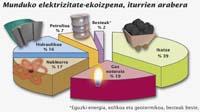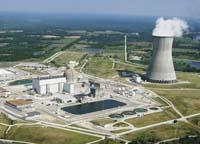2008/11/01
247. zenbakia

eu es fr en cat gl
Aparecerá un contenido traducido automáticamente. ¿Deseas continuar?
Un contenu traduit automatiquement apparaîtra. Voulez-vous continuer?
An automatically translated content item will be displayed. Do you want to continue?
Apareixerà un contingut traduït automàticament. Vols continuar?
Aparecerá un contido traducido automaticamente. ¿Desexas continuar?
Ranking of contamination by electric sources
Text created by automatic translator Elia and has not been subsequently revised by translators.
Elia Elhuyar
The electricity market is facing a series of opposing interests such as money, energy demand, or ecology. Therefore, it is often tended to relativize the benefits and damage of each energy source. A recent study, however, has evaluated in detail the environmental impact that each production technology generates and compared the results obtained.
Ranking of contamination by electric sources
01/11/2008 | Urruzola Arrate, Manex | Elhuyar Zientzia Komunikazioa

(Photo: European Union)
The availability and prosperity of the current energy allows many people to enjoy comfort and mobility in an unprecedented measure. But for this, man spends an average of energy 100 times more than before using fire. And we must take into account the pollution and environmental impact that this energy consumption entails.
A third of the total energy production is destined to the generation of electricity. The rest is mainly intended for transport and heating. Electricity generation requires the exploitation of various energy sources, such as coal, oil, natural gas or uranium. In fact, electricity is an efficient and clean energy for consumption, but it generates environmental impacts in its generation phase.
In any case, it is not possible to put all the energy sources at the same level, at least as regards pollution. Not generalizable. All technologies that produce electricity pollute more or less. Therefore, by consuming electricity, in any case, we are polluting the environment. That is inevitably so. But, starting to compare, there are differences between each other. The recent research carried out by the Catalan environmental and energy consultant, AUMA, highlights the great differences between the environmental impacts of electricity sources.
The results show that the technologies that use fossil fuels are the ones that have the greatest environmental impact. Of these, coal and oil are the main pollutants, with lignite plants being the most polluting. The plants with lower environmental impact are hydroelectric and wind farms.
Exploitation of the most polluting sources

(Source: International Energy Agency. 2004)
After the results, flashy data appear. In fact, energy sources with the greatest environmental impact are the most exploited. Coal is, by far, the most used fuel in the world to generate electricity. As for the electrical system of the Spanish state, coal and natural gas are the most exploited, generating between them half of the total electricity of the state and closely following the nuclear.
Those responsible for this are fundamentally economic. The exploitation of fossil fuels and nuclear energy has always been very economical technologically compared to renewable energies. In addition, thermal power plants have an almost total utility throughout the year and produce much more than renewables. In fact, the production of renewables largely depends on time -- sun, wind and flow are not always guaranteed. Since the electricity market pays each producer based on the kWh or generated energy units, the most polluting production technologies have offered great business opportunities. But things are changing little by little.
We must take into account the economic incentives that renewable producers receive from governments. In addition, the development of renewable energy technology increases its efficiency over the years. Thus, each unit of energy generated by wind power plants or photovoltaic panels is increasingly economical. In addition, the environmental impact of these technologies has decreased considerably in recent years.
The most significant example is that of photovoltaic cells. If the ACV 1999 and 2008 studies of the company AUMA are compared, the environmental impact score of the photovoltaic facilities has been reduced almost 5 times. The key to this change lies in the materials of the photovoltaic panels, which in the last ten years have improved notably in quality and contagiousness. And the photovoltaic industry is constantly reducing its costs. For all this, renewable energy facilities have increased considerably in recent years thanks to energy demand and business opportunities.

(Photo: From archive)
Economic effects of damage: external costs
Beyond the economic costs of some and other technologies, we must also take into account the environmental and social costs associated with each energy source. These costs, known as “external costs”, analyze the economic implications of each manufacturer of electricity for human health, ecosystems, crops, buildings and the greenhouse effect, among others. We take into account, for example, the considerable losses that occurred in the case of the Prestige or the expenses that imply for public health the emissions of polluting gases.
The External Report of the European Commission has estimated the monetary value of external costs. This means that if these costs were expressed in the bill of light, electricity from coal and oil would have to be added an average of 5 cents per kWh. On the contrary, the external cost of electricity generated by hydroelectric power plants is 0.4 cents, while the cost of wind power is only 0.15 cents. These values vary from country to country, but the difference between fossil fuels and renewable energies is evident. According to the authors of the report, these data should be taken into account in political actions, for example, by taxes or ecorates to the most harmful fuels and technologies, or by incentives to producers of electricity with lower socio-ecological cost. The subject, however, has many vertices and is about to see the measures to be taken.
Challenges of the future

Although all sources of electricity have an environmental impact, hydroelectric technology is the least polluting.
Donna Stooksbury
The demand for energy continues to grow year after year and the electric system has each and every energy source needed to respond to this demand: this argument is gaining strength in recent times. In addition, despite the disadvantages, many experts believe that in the future it will have to be reinforced, especially arguing that the vacuum that will leave the oil crisis will have to be filled in some way.
Oil and natural gas reserves only offer for decades. With the current production level and fuel deposits known so far, oil reserves are only guaranteed for about 40 years and natural gas is only available for 60 years. Coal will run out in less than three centuries. In addition, reserves are not the only problem of the energy sector, but the exponential growth of world consumption.
It will not be possible, therefore, to supply more with less: the rope will be cut on either side. In the society of the future, the model of civilization and consumption habits must be necessarily modified to achieve true energy viability.

(Source: BP Statistical Review of World Energy. 2008)
But that doesn't have to be a disaster: there are significant examples around the world. In Japan, for example, very few people use the particular car to move, and in that society it is unthinkable that each person owns a car. In London, traffic was solved when they started charging to access the city centre and in Denmark the taxes go up a lot. They are decisions contrary to the majority will, but without great margins of manoeuvre.
We will have to see what measures will be taken in the near future and how society will respond to these measures. And the key will be how all this is managed.
Environmental impact study
AUMA has carried out a Life Cycle Analysis (LCA) to analyze the environmental impact of each electric generation technology. This method takes into account the environmental impacts of each technology throughout its entire life: raw materials exploited, production process, uses and treatments, emissions and waste generated, recycling... that is to say, the route from the place of birth to the tomb is analyzed. The study includes parameters such as used soil, generated radiations, sound and vibrations, necessary constructions and attacked biodiversity.

Source: AUMA. 2008 2008 2008 2008 2008
(Photo: G. G. Roa)
The harmful effects of each technology are divided into four groups: effects on human health, damage to the ecosystem, exploitation of raw materials and effects on climate change. Each damage or impact is quantified according to normalized values, being the sum of all points that represents the environmental impact of each electric source. Finally, depending on the number of points, in the ranking one or another position is assigned to each technology. In the chart you can see a summary of the conclusions.
Fossil fuels, first places in the pollution ranking
All thermal power plants work in the same way: the thermal energy generated from fossil fuels turns an electric generator through a turbine. As for the affections to the environment, we highlight the emissions of carbon dioxide and other inorganic substances to the atmosphere. These emissions produce global warming and breathing problems respectively.
Coal is the fuel that emits more greenhouse gases. Among the different types of coal, the lignite is the one that has the greatest environmental impact, since its calorific power is less than anthracite and coal, so its efficiency is less.

(Photo: voestalpine Stahl GmbH)
The oil plants are in the process of extinction and the electricity they generate is used only to supply the moments of greater energy demand.
As for the combined cycle plants that use natural gas, there has been an important increase in recent years. Greater efficiency compared to other fossil fuels and lower emission of gases.
Nuclear energy, the advantage of probability
Nuclear technology is a controversial energy source. The nuclear power plants do not emit gases, but in case of a serious accident the environmental impact would be disastrous. The probability of this happening is very low. On the other hand, recent mild accidents have given much to talk about and the debate about the antiquity of Western nuclear power stations has resurfaced.

(Photo: tickets)
The environmental impacts of nuclear power plants are analyzed based on the radiation that generates their activity, the treatment and storage of the radioactive waste generated and the ecotoxicity in the surrounding waters.
The fuel of nuclear energy is uranium. In nuclear power plants, the large amount of energy released by dividing the nuclei of atoms is used to produce electricity.
Hydroelectric, wind and photovoltaic systems
The classic form of obtaining energy is that of hydroelectric power plants. A water jump moves a turbine that is used to generate electricity. This is the technology with the lowest environmental impact associated with the construction of power plants, mainly cement and machinery fuels.

(Photo: fcimpiantielettrici)
Wind power plants transform wind energy into electricity through wind turbines. The environmental impact of these plants is mainly due to the extraction of minerals for the production of wind towers and the extension of the soil they occupy in their operation. We must also take into account the damages that can cause in the birds of the area.
On the other hand, it is photovoltaic technology with the greatest environmental impact of renewable energies. Solar panels transform solar radiation into electrical energy, but their production requires the waste of energy and raw materials. For this reason, the production of photovoltaic panels entails gas emissions, liquid discharges and waste. Although in recent years the quality and pollution of the plates has improved remarkably, at present the main challenge of the photovoltaic industry is the reduction of costs and not the increase of the performance of the plates.
The power of renewables
The amount of energy that can be generated by taking advantage of the strength of the sun and wind in the Iberian peninsula is much higher than the electricity demand in this territory. This is one of the conclusions of the Renovables 2050 report developed by the Institute of Technological Research (IIT) for Greenpeace. These data indicate that a total use of the strength and possibilities of renewable energies would allow to supply 56 times the electricity demand in the Iberian peninsula.
Despite data from Euskal Herria, the conclusions of the report are positive: if the possibilities of solar and wind energy were fully exploited, the energy demand of the population could be covered 15 times. However, the report concludes that the hydroelectric potential is very limited, since it would not cover 5% of the total demand for electricity in the Basque Country.

(Photo: Peterm/350RF)
In view of the conclusions of the Renovables 2050 report, Greenpeace has requested incentives and tax bonuses for renewable energies. In addition, the environmental organization has called for the elimination of all subsidies to fossil fuels, nuclear and thermal power plants and the implementation of ecorates for external costs.
The supply of renewable energies to current electricity consumption would mean a significant reduction in the environmental impact, especially in terms of global warming, the depletion of raw materials and harmful emissions. On the other hand, wind and photovoltaic technology would increase the exploitation of minerals and the occupation of the soil. However, in general, with respect to the current electrical system of the Iberian peninsula, the environmental impact score of renewable energies would be 5.8 times lower according to the AUMA ACV method.
Urruzola Arrate, Manex
Services Services Services
247 247
2008 2008 2008 2008 2008
Results Results Results
031 031 031
Energy Energy Energy
Article Article Article
Services Services Services















